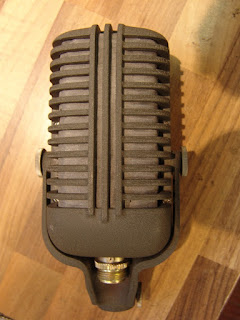Carbon microphones were one of the earliest audio transducers, and were used for radio broadcasts up until the mid 1930s, when they were superseded by ribbon microphones.
They were really simple devices, with small particles of carbon packed into a space between two electrodes and pressed against a plastic, mica, rubber, or wax paper diaphragm. When connected to a battery supply, a current flows through the mic which is modulated as the sound impinging on the diaphragm compresses and releases the carbon particles.
 |
| Old carbon microphone – unknown manufacturer |
I have been meaning to investigate carbon mics for some time, so when a couple came up for sale for £10 each, it seemed like the perfect opportunity to get my hands dirty. Literally. In German these are called Kohlemikrofon, which also translates as ‘coal microphone’. 🙂
 |
| Carbon microphone with the diaphragm and carbon removed. |
The body of the mic is made of an insulating material, in this case a block of marble. The classic Marconi-Reisz microphone also used marble – this one is clearly a copy of that mic. Others had bodies made of wood, which must have been cheaper to make. Four hooks screwed into the body would have been used to suspend the mic within a metal ring, using springs or rubber rings, like this nice example at the ORBEM website.
 |
| Old diaphragm and grill from a carbon mic |
After many decades this example is in pretty poor shape: most of the carbon has escaped into the wild, and the diaphragm is cracked and perforated. I wanted to try and get this working again, for fun and as a learning experience.
 |
| Clean again! |
The first step was to clean everything up in the ultrasonic bath, and the brass terminals were given a scrub. At least it looks better! The carbon will sit in the depression between the two brass terminals.
 |
| New diaphragm ! |
I made a new diaphragm by stretching a sheet of thick cellophane over the bakelite frame that makes up the front of the mic, and then heated it gently with a hot air gun. The plastic film shrinks and pulls itself tight. It looks neat and has a similar thickness to the original – as far as I can tell.
It took me a little while to work out the purpose of this big screw in the base of the mic. It is in fact for filling the microphone.
Then the mic can be re-assembled and filled with new carbon granules. It takes a few goes to pack the carbon, shaking the mic in between each fill.
 |
| Carbon microphone circuit, from the TFPro website. |
I tried a circuit inspired by the one above, using a battery and transformer. Ideally the transformer should be gapped, or a capacitor used to block the DC, to prevent saturation.
With a new diaphragm and new carbon, the microphone does now pick up sound, and although it is far to noisy for any serious recording, I was pleased just to get that far in my first attempt. As always with microphones, the art is in the detail and I can now at least appreciate some of the design parameters than need to be considered. These include
- Diaphragm material, tension, thickness and stiffness. The diaphragm needs to be thin and compliant enough to vibrate, yet stiff enough to transfer the energy to the carbon granules. Cellophane may perhaps be too flexible, but glass or hard plastic could be too stiff.
- Carbon granule type, size and packing. The carbon needs to be compress reversibly by the diaphragm, otherwise it will pack and stop working.
- Impedance. I noticed that the impedance of the mic dropped from about 10K ohms to 1K ohms on tightening the filling screw. Clearly some pressure on the granules makes a big difference to the impedance, and also made an audible difference to the sound of the mic.
- Terminal size and shape. The contact with the carbon granules will affect the impedance of the mic and the efficiency.
- Circuit. Varying the voltage across the mic made a noticeable difference to the noise level. The transformer should be capable of taking some DC current, or a capacitor used to block the DC. (which is how I did it)
There is also a nice blog post about carbon mics at Preservation Sound.













